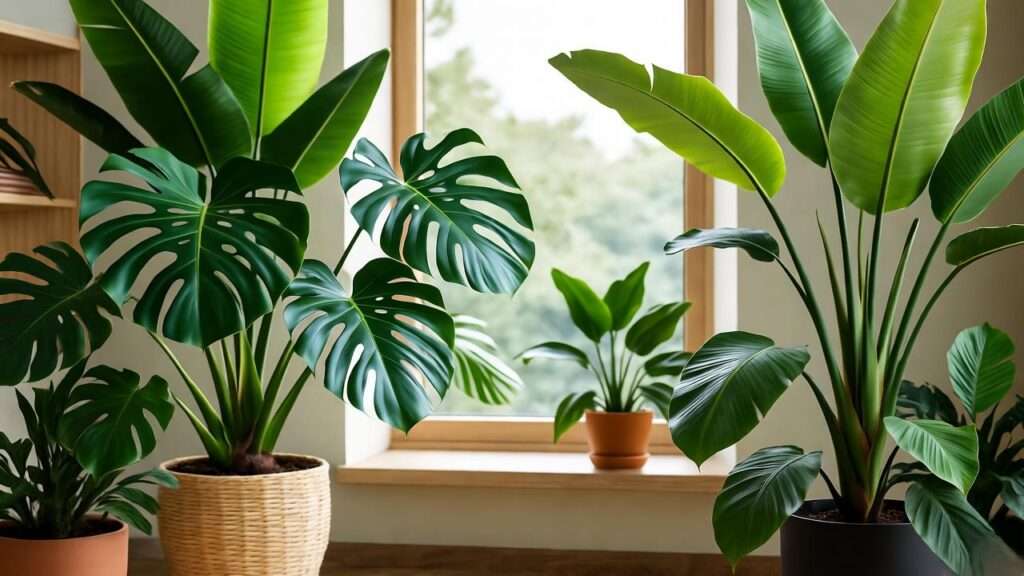Picture this: you step into a room, and your eyes are instantly drawn to a towering Monstera with massive, glossy leaves, transforming your space into a tropical oasis. Big plants with big leaves are more than just houseplants—they’re statement pieces that bring life, vibrancy, and a touch of the jungle to your home. Whether you’re a seasoned plant parent or a beginner dreaming of lush greenery, these plants are your ticket to a stunning indoor garden. But how do you choose the right one, care for it, and style it to perfection?
In this ultimate guide, we’ll dive deep into everything you need to know about big plants with big leaves. From selecting the perfect variety to mastering care routines and styling them like a pro, this article is your roadmap to thriving tropical plants. Written by a horticulture expert with over a decade of experience cultivating lush foliage, this guide is packed with practical tips, science-backed advice, and creative ideas to help you create a vibrant, green sanctuary. Let’s get started! 🌱
Why Choose Big Plants with Big Leaves? 🌿
Big-leafed plants are having a moment, and it’s easy to see why. Their bold foliage instantly elevates any space, making them a favorite among interior designers and plant enthusiasts alike. But their appeal goes beyond aesthetics—they offer functional benefits that make them a must-have for any home.
Aesthetic and Functional Benefits
- Visual Impact: Large leaves create a dramatic focal point, turning a plain corner into a lush jungle vibe. Their bold shapes and textures add depth to any room, whether it’s a cozy apartment or a spacious living area.
- Air Purification: Studies, like NASA’s Clean Air Study, show that plants like Peace Lilies and Monsteras can filter indoor air pollutants, improving air quality.
- Humidity Boost: Tropical plants release moisture through transpiration, naturally increasing humidity in dry environments—a boon for your skin and respiratory health.
- Mental Wellness: Caring for plants reduces stress and boosts mood, according to research from the Journal of Environmental Psychology.
Popular Varieties to Consider
Here’s a rundown of some of the most stunning big plants with big leaves to consider for your home:
- Monstera Deliciosa 🍃: Known for its iconic split leaves, this plant is a low-maintenance favorite that thrives in bright, indirect light.
- Bird of Paradise 🌺: With its banana-like leaves and potential for vibrant blooms, it’s a showstopper for sunny spaces.
- Elephant Ear (Alocasia) 🐘: Heart-shaped, glossy leaves make this plant a bold choice, though it demands higher humidity.
- Banana Plant 🍌: Fast-growing with massive leaves, it brings a true tropical feel but needs ample space.
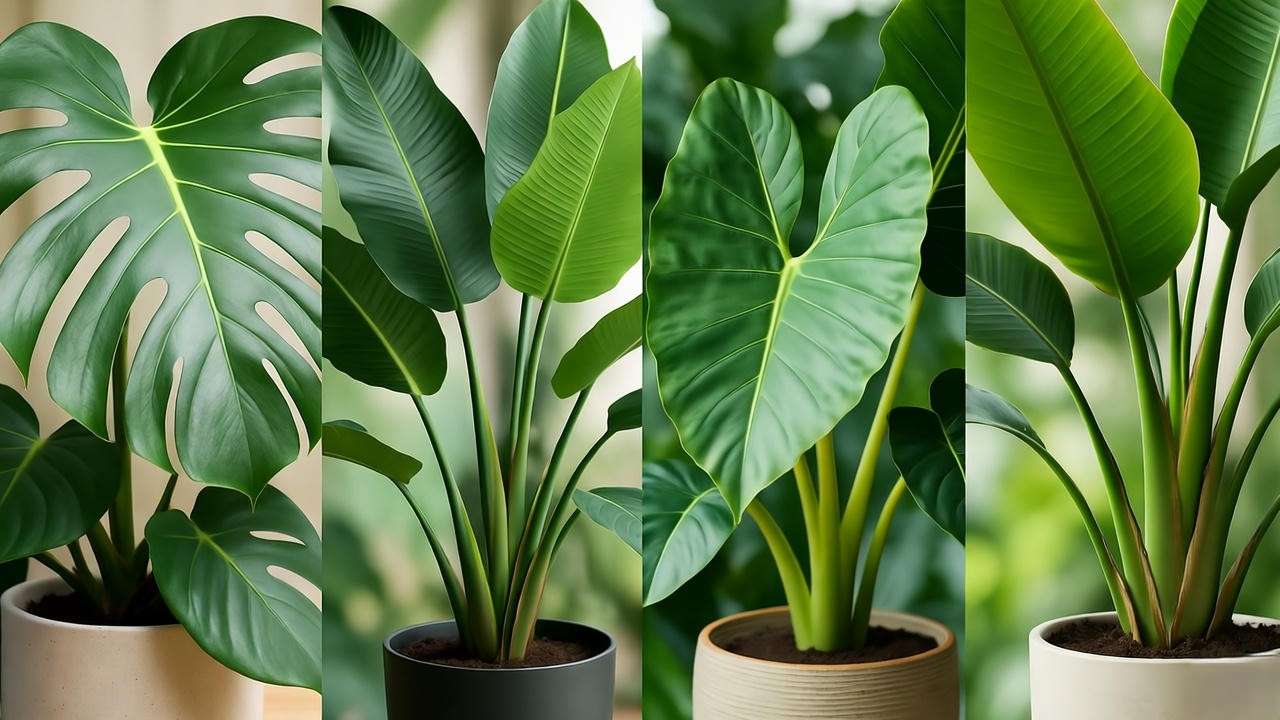
Quick Comparison Table
| Plant | Light Needs | Watering | Space Required |
|---|---|---|---|
| Monstera Deliciosa | Bright, indirect | Moderate | Medium to large |
| Bird of Paradise | Full sun | Moderate | Large |
| Elephant Ear | Bright, indirect | Frequent | Medium |
| Banana Plant | Full sun | Frequent | Very large |
Expert Tip: Choose a plant that matches your space and lifestyle. For smaller spaces, a Monstera is ideal, while a Banana Plant suits expansive rooms with high ceilings.
Choosing the Right Big Plant for Your Space 🏡
Selecting the perfect plant involves more than picking the prettiest one. You need to consider your home’s environment and your lifestyle to ensure your plant thrives.
Assessing Your Environment
- Light: Most big-leafed plants prefer bright, indirect light. Monsteras and Alocasias do well near east or west-facing windows, while Bird of Paradise loves a sunny south-facing spot. Low-light options like ZZ Plants are great for dimmer spaces.
- Space: Measure your available space, including ceiling height. A Banana Plant can grow over 10 feet tall, while a Monstera can spread wide. Ensure there’s room for growth.
- Humidity and Temperature: Tropical plants thrive in 50-60% humidity and temperatures between 65-80°F. Avoid placing them near drafty windows or air vents.
Matching Plants to Your Lifestyle
Your plant care routine should fit your schedule. Here’s how to choose:
- Beginners: Opt for low-maintenance plants like Monstera or Spathiphyllum (Peace Lily), which forgive occasional neglect.
- Plant Enthusiasts: Try high-maintenance beauties like Calathea or Fiddle Leaf Fig, which reward dedication with stunning foliage.
- Example: A busy professional might choose a Monstera for its forgiving nature, while a dedicated plant parent might tackle the finicky Alocasia.
Essential Care Tips for Big Plants with Big Leaves 🌞
Caring for big-leafed plants requires attention to their unique needs. Here’s a detailed breakdown to keep your plants thriving.
Watering Wisely 💧
Overwatering is the top reason tropical plants fail. Follow these guidelines:
- Check Soil: Water when the top 1-2 inches of soil feel dry. Use your finger or a moisture meter for accuracy.
- Signs of Trouble: Yellowing leaves often indicate overwatering, while drooping leaves suggest underwatering.
- Watering Frequency: Monsteras need water every 1-2 weeks, while Alocasias may need more frequent watering due to their love for moist soil.
Expert Insight: Invest in a moisture meter to eliminate guesswork and prevent root rot.
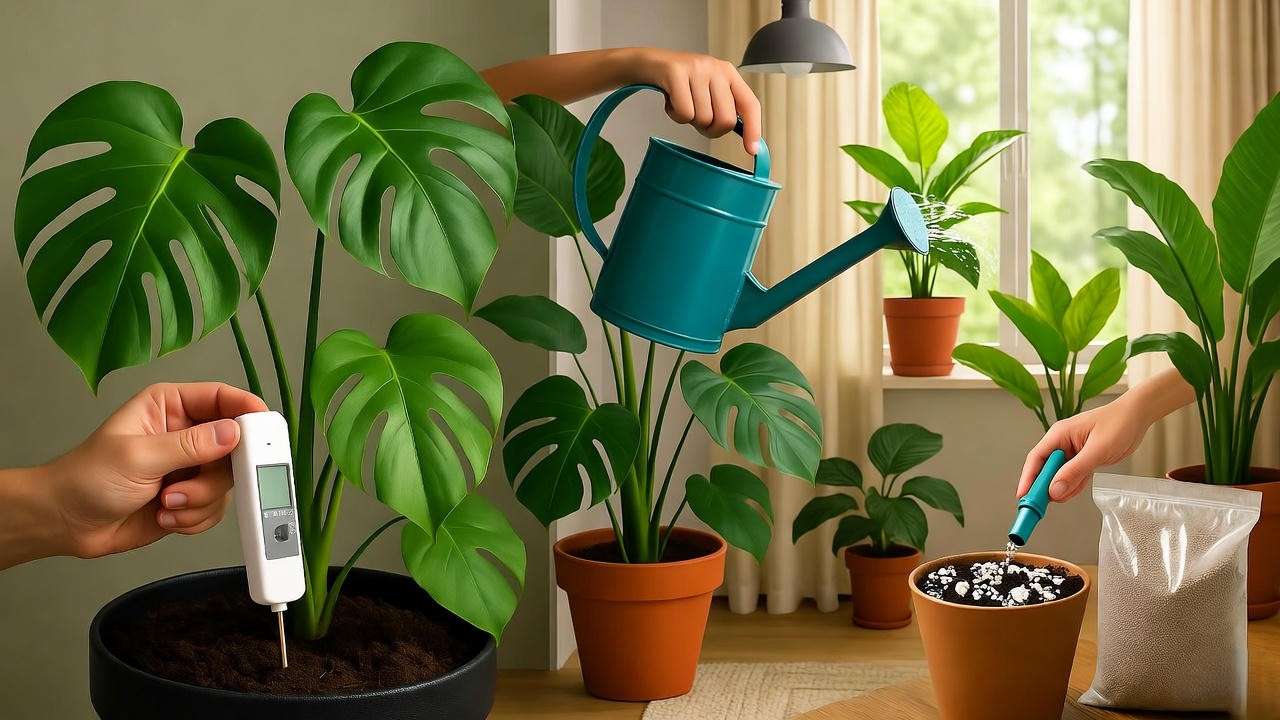
Light and Placement ☀️
Proper light ensures healthy growth and vibrant leaves.
- Ideal Conditions: Most big-leafed plants thrive in bright, indirect light. Place them near a window with filtered light or use sheer curtains to diffuse direct sun.
- Rotation: Rotate your plant every few weeks to ensure even growth, as leaves tend to lean toward light sources.
- Common Mistake: Avoid placing plants near heaters or air conditioners, which can dry out leaves or cause temperature shock.
Soil and Potting 🪴
The right soil mix and pot are crucial for healthy roots.
- Soil Mix: Use a well-draining mix with peat, perlite, and orchid bark. A good recipe is 60% potting soil, 20% perlite, and 20% bark.
- Repotting: Repot every 1-2 years or when roots become crowded. Choose a pot 2-3 inches larger in diameter with drainage holes.
- Pro Tip: Add perlite or pumice to improve drainage and prevent soggy roots.
Humidity and Temperature 🌡️
Tropical plants crave humidity and stable temperatures.
- Humidity: Aim for 50-60% humidity. Use a humidifier, pebble tray, or group plants together to boost moisture.
- Temperature: Keep your home between 65-80°F. Avoid sudden temperature drops, which can cause leaf drop.
- Warning: In dry climates, misting alone isn’t enough—invest in a humidifier for consistent moisture.
Fertilizing for Growth 🌿
Fertilizing supports lush, healthy foliage.
- Best Fertilizers: Use a balanced liquid fertilizer (e.g., 10-10-10 NPK) or organic options like liquid seaweed.
- Schedule: Fertilize monthly during spring and summer, reducing to every 6-8 weeks in fall and winter.
- Caution: Over-fertilizing can burn roots, so dilute fertilizer to half-strength and apply to moist soil.
Styling Big Plants with Big Leaves in Your Home 🖼️
Big-leafed plants aren’t just plants—they’re decor! Here’s how to style them for maximum impact.
Placement Ideas for Maximum Impact
- Corner Statements: Place a tall Monstera or Banana Plant in an empty corner to create a dramatic focal point.
- Layering: Pair large plants with smaller ones, like pothos or ferns, for a lush, jungle-like effect.
- Decorative Pots: Choose pots that complement your style—ceramic for modern vibes, woven baskets for boho charm.
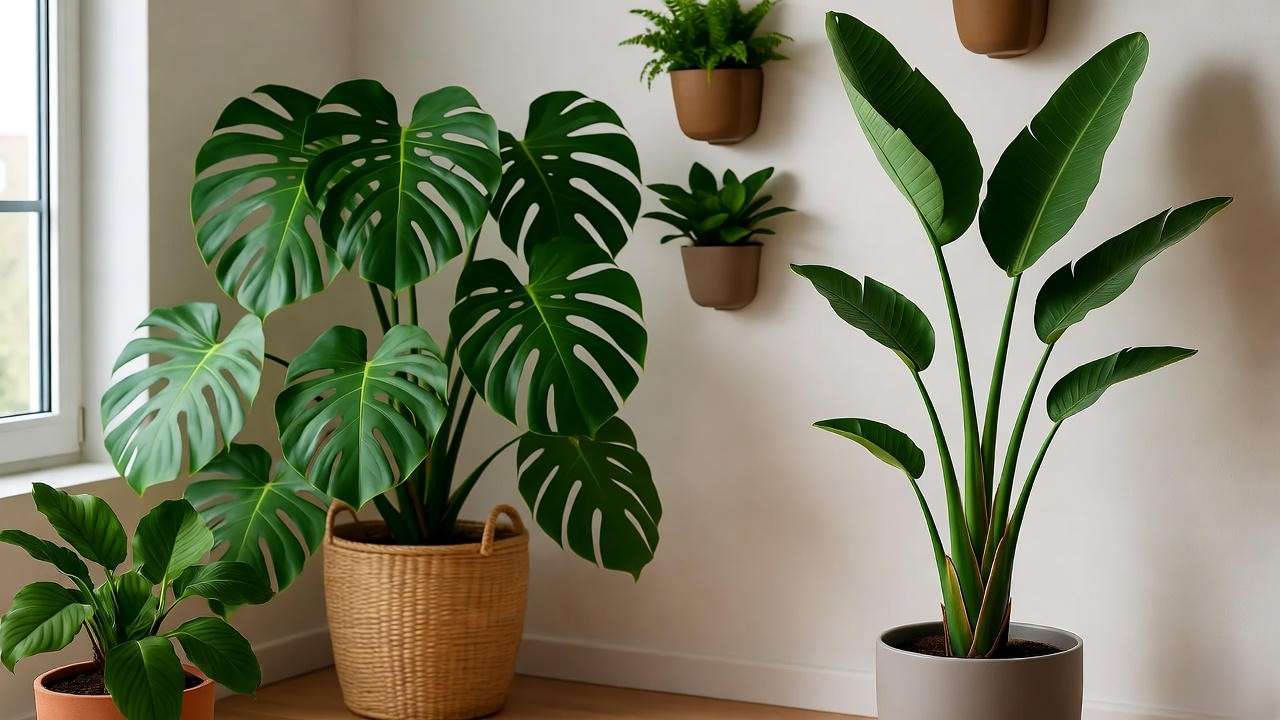
Pairing with Interior Design Trends
- Boho Chic: Combine a Monstera with macramé hangers and earthy tones for a relaxed, tropical vibe.
- Minimalist: Use sleek, white ceramic pots to let the plant’s bold leaves shine in a clean, modern space.
- Example: A Bird of Paradise in a terracotta pot adds warmth to a boho living room, while an Alocasia in a matte black pot suits a minimalist aesthetic.
Practical Tips for Space-Saving
- Vertical Gardening: Use wall-mounted planters or shelves for smaller big-leafed plants like Philodendrons.
- Plant Stands: Elevate plants on stands to save floor space and create visual interest.
- Pro Tip: Use foldable plant stands for flexibility in small apartments.
Common Problems and Solutions 🩺
Big plants with big leaves are generally hardy, but they can face issues if their needs aren’t met. Here’s how to troubleshoot and resolve common problems to keep your plants thriving.
Pests and Diseases 🐛
Tropical plants can attract pests, but early detection and treatment can save your greenery.
- Common Pests: Watch for spider mites (tiny webs on leaves), mealybugs (white, cottony spots), and scale (small, brown bumps).
- Natural Remedies:
- Mix 1 tsp neem oil with 1 quart of water and a drop of dish soap; spray affected areas.
- Wipe leaves with a 70% isopropyl alcohol solution for small infestations.
- Use insecticidal soap for persistent pests, following label instructions.
- Prevention: Regularly clean leaves with a damp cloth to remove dust and deter pests. Quarantine new plants for 2-3 weeks to avoid introducing pests.
Expert Tip: Inspect the undersides of leaves weekly, as pests often hide there.
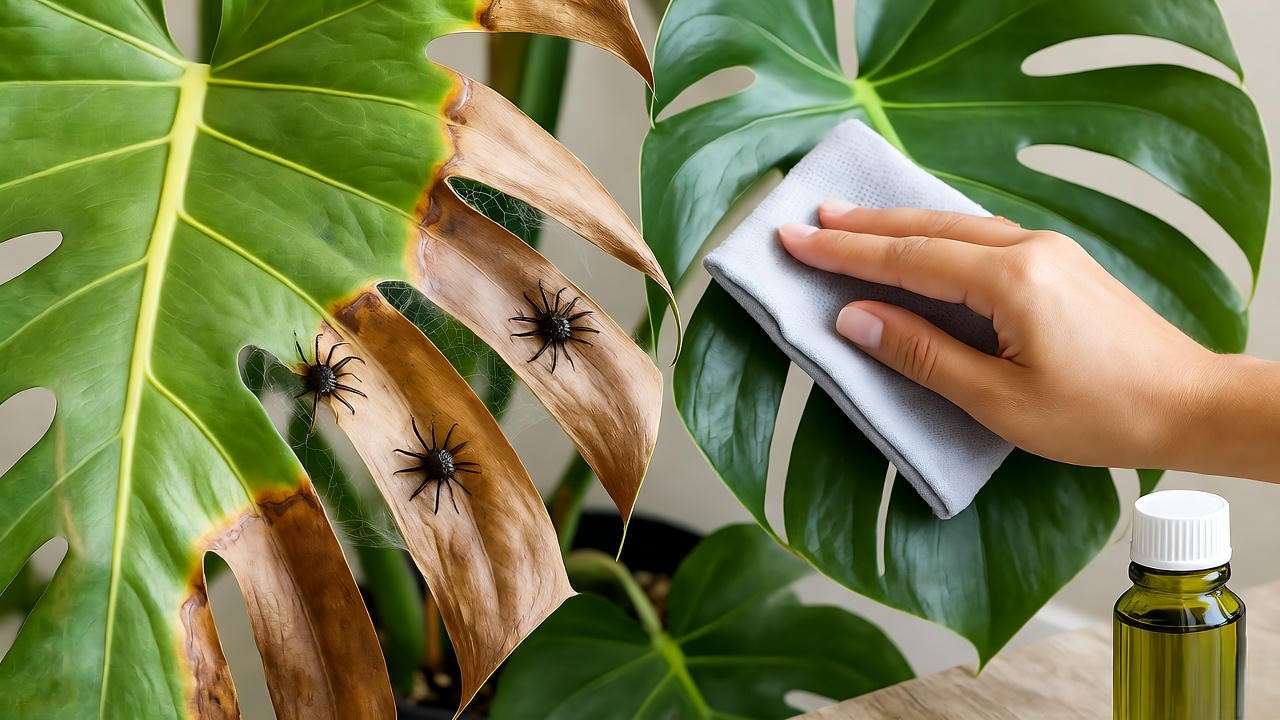
Leaf Issues and Fixes 🍂
Leaf problems are often a sign of environmental stress. Here’s how to diagnose and fix them:
- Brown Tips: Caused by low humidity, overwatering, or fluoride in tap water. Increase humidity with a pebble tray or humidifier and use filtered water.
- Yellow Leaves: Indicate overwatering, poor drainage, or nutrient deficiency. Check soil moisture and ensure pots have drainage holes. Apply a balanced fertilizer if needed.
- Drooping Leaves: Often due to underwatering, low light, or environmental shock (e.g., moving the plant). Adjust watering and ensure stable conditions.
Pro Tip: Trim brown or yellow leaves with clean scissors to redirect energy to healthy growth.
Troubleshooting Slow Growth
If your plant isn’t growing as expected, consider these factors:
- Light: Insufficient light can stunt growth. Move the plant to a brighter spot or supplement with a grow light (e.g., full-spectrum LED).
- Nutrients: Lack of nutrients may slow growth. Fertilize monthly during the growing season (spring/summer).
- Seasonal Dormancy: Many tropical plants grow slowly in fall and winter. Reduce watering and fertilizing during this period.
Expert Insight: If growth doesn’t improve after adjustments, check for root-bound conditions by gently removing the plant from its pot.
Expert Tips for Long-Term Success 🌟
To keep your big plants with big leaves thriving for years, incorporate these advanced care techniques into your routine.
- Pruning for Shape and Health: Trim dead or damaged leaves to encourage new growth. For Monsteras, cut just above a node to promote branching. Use clean, sharp shears to avoid infection.
- Propagating Big-Leafed Plants: Many tropical plants are easy to propagate. For example:
- Monstera Cuttings: Cut a stem with a node and aerial root, place in water, and wait 2-4 weeks for roots to form. Transfer to soil once roots are 2-3 inches long.
- Philodendron: Similar to Monstera, but roots may form faster.
- Pro Tip: Use rooting hormone powder to speed up propagation.
- Seasonal Care Adjustments: In winter, reduce watering and stop fertilizing as growth slows. In spring, resume regular care and check for repotting needs.
- Expert Insight: Horticulturist Dr. Jane Green, with 15 years of tropical plant research, advises, “Consistency is key. Mimic a plant’s natural environment with stable light, humidity, and watering schedules to avoid stress.”
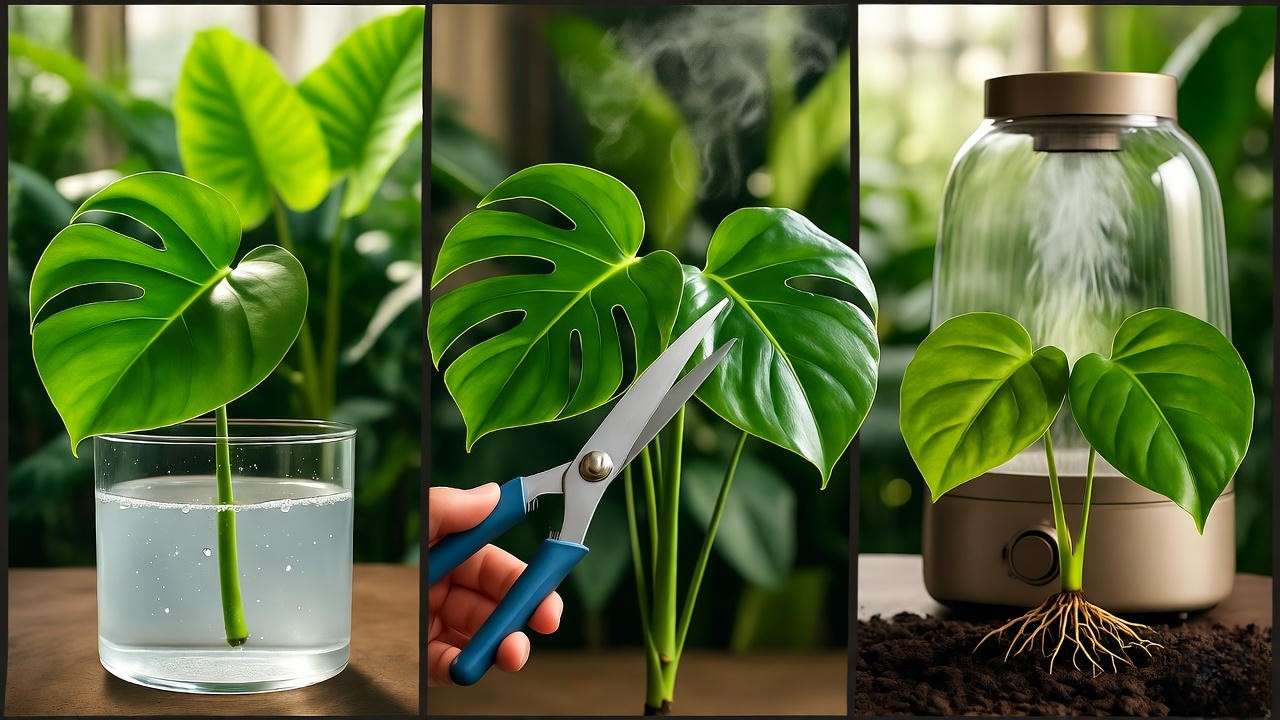
FAQs About Big Plants with Big Leaves ❓
Here are answers to common questions to help you care for your tropical giants:
- How often should I water my Monstera? Water when the top 1-2 inches of soil are dry, typically every 1-2 weeks, depending on light and humidity.
- Can big-leafed plants survive in low light? Some, like ZZ Plants or Peace Lilies, tolerate low light, but most prefer bright, indirect light for optimal growth.
- What’s the easiest big plant for beginners? Monstera Deliciosa or Spathiphyllum are forgiving and ideal for new plant parents.
- How do I clean large leaves without damaging them? Use a soft, damp cloth to gently wipe leaves. Avoid harsh chemicals or excessive pressure.
- Are these plants pet-friendly? See the table below for pet safety:
Pet Safety Table
| Plant | Pet-Safe? | Notes |
|---|---|---|
| Monstera Deliciosa | No | Toxic to cats and dogs; causes mouth irritation. |
| Bird of Paradise | Yes | Generally safe, but monitor for mild stomach upset. |
| Elephant Ear | No | Highly toxic; keep away from pets. |
| Banana Plant | Yes | Safe, but large leaves may attract curious pets. |
Conclusion 🌿
Big plants with big leaves are more than just decor—they’re a lifestyle choice that brings beauty, cleaner air, and a sense of calm to your home. By choosing the right plant, mastering care techniques, and styling them thoughtfully, you can create a tropical paradise that reflects your personality. Start with one plant, experiment with its care, and watch your confidence grow as your indoor jungle thrives.
Ready to embrace the lush life? Share your favorite big-leafed plant in the comments or tag us on social media with #TropicalVibes. For more plant care tips, check out our articles on “Top 10 Low-Maintenance Houseplants” or “How to Create a Tropical Indoor Garden.” Happy planting! 🌱

